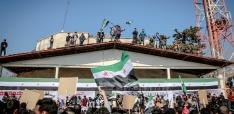The Events of Ukraine in Perspective

This week Trump and Putin will meet to try to find an exit to the war in Ukraine. In this column Toro Hardy explains how Putin wrongly believed that history could be rewritten quickly and without significant costs, opening a Pandora’s box that turned his country upside down. A much-needed perspective to understand the events that will unfold with this week's meeting.
To understand Russia’s reasons for invading Ukraine, it is necessary to refer to two constants in the country’s mindset since Tsarist times, as well as two variables determined by Putin’s personal mindset.
Constants and variables
The first of the two constants would be the self-perceived idea of Russia as a unique and singular nation. Just as the United States views itself as an exceptional country in the annals of humanity, and China has historically regarded itself as a “Middle Kingdom” with the rest of the world revolving around it, Russia has considered itself as the “Third Rome”. That is, as the natural heir, through the Byzantine civilization from which it absorbed its cultural and religious cues, of ancient Rome. This exalted self-view has always demanded a proportional role in world affairs.
The second constant is the historical perception of vulnerability derived from its particular geography. Lacking natural borders beyond those provided by sea, Russia has felt perpetually unguarded against penetration by hostile forces. In fact, invasions have not lacked: Sweden’s Charles XII in the 18th century, France’s Napoleon in the 19th, and Germany’s Wilhelm II and Adolf Hitler in the 20th. This has led Russia to a drive to expand its borders, seeking to compensate through territorial depth the natural barriers that its geography denies it. The absorption of neighbouring states or the presence of buffer states have always been among its preferred security options.
These constants are compounded by two variables determined by Putin’s deepest convictions. Firstly, the idea that the disintegration of the Soviet Union represented the greatest tragedy of the 20th century. This entailed the loss of two million square miles of the USSR’s territory (larger than the entire territory of India of 1.3 million square miles), as well as the loss of 25 million ethnic Russians who became citizens of neighbouring countries. This, on top of the sudden decline suffered by Moscow’s international hierarchy, which according to Putin translated into severe humiliation inflicted by an overbearing West.
Secondly, Putin’s deep belief that the notion of Ukraine as a sovereign state was a mere fiction derived from the creation of the Soviet Union in 1922. Since the confederation of tribes that formed Kievan Rus in the 9th century, Ukraine has always been united with Russia, something that was artificially altered by Lenin’s desire to project the idea that Russia and Ukraine were different countries within the Soviet Union. With the collapse of the USSR, this fictional distinctiveness took hold when Ukraine became part of United Nations.
Western actions and Putin’s decision making
Given factual support to much of Putin’s resentment towards the West was the triple package of policies undertaken by it since the disintegration of the Soviet empire in 1989, and that of the Soviet Union in 1991. This package was formed by NATO’s expansion, the enlargement of the European Union and democracy promotion. While NATO grew increasingly closer to Russia’s borders in four successive phases of membership growth, the European Union successively provided membership to former satellites or constituent countries of the defunct Soviet Union. This was aggravated by the support provided to the pro-democracy colour revolutions in Ukraine, Georgia, and Kyrgyzstan, which fell under the so-called “Freedom Agenda” promoted by Washington (Cooley and Nexon, 2020, p. 52).
Even realists within America’s foreign policy establishment objected to aspects of the above. George Kennan did not understand the rationality of NATO’s expansion as no one in Europe was threatening anybody else. John Mearsheimer and Stephen Walt believed that such expansion was interfering with Russia’s traditional sphere of influence, which at some point would push Moscow to react. Henry Kissinger was particularly worried about NATO’s approach to Ukraine, a flat land extension that had been crossed by Napoleonic France and Imperial and Nazi Germany to invade Russia. He also criticised Washington’s lack of understanding of the special meaning that Ukraine held for Russia. Kenneth Waltz believed that overwhelming power (like NATO’s expansion), repelled and led others to balance it (Stent, 2014, pp. 69-75; Mearsheimer, 2014; Haroche, 2023; Kissinger, 2014; Waltz, 2000).
Thus, a combination of constants in Russian history, variables represented by Putin’s personal convictions and accumulated resentment towards the actions taken by the West, determined the frame of reference surrounding Russia’s invasion. However, the fear that a country as historically close to Russia as Ukraine could become part of the Western sphere was the decisive factor.
In Putin´s mind the confluence of several elements seemed to have made 2022 the right moment to take action. First, time was playing on behalf of Ukraine´s military buildup. Second, the European Union´s energy vulnerability and Germany’s dependence on Russian gas would presumably translate into a timid attitude towards an invasion of Ukraine. Third, the strategic alliance with China would significantly offset the impact of potential Western sanctions. Fourth, the extreme political polarization within the United States seemed to have weakened that country’s resolve and, by extension, NATO’s cohesion.
Although some of these assumptions proved to be flawed, they fit within a rational cost-benefit analysis. However, within it was also a fundamental premise that ended up being totally wrong: The notion of swift Russian military action able to decapitate in just a few days the ruling regime and seize control of Ukraine. The utter failure of this premise completely changed the nature of the equation herein involved, including that of placing the West in front of an accomplished fact, thus exponentially increasing Russia’s costs.
Costs and plausible justifications
After 41 months of a protracted war of attrition some of those Russian costs have been the following. First: 250,000 confirmed dead and 750,000 wounded (Sauer, 2025). Second: Around 40% of government spending going into defence, with industrial resources being diverted from civilian use, which reinforces a war-driven economy with shrinking global relevance (Tan, 2025). Third: Armament losses that include 11,819 tanks and armoured vehicles and 305 aircrafts, within more than 20,000 losses in overall military equipment, all of which translates into declining deterrence and military capability (Saradzhyan, Arreguin-Toft and Flood, 2025). Fourth: Sweden’s and Finland’s accession into NATO, which not only strengthened the alliance but brought into it all of Russia’s Baltic Sea neighbors Fifth: An estimated US$340 billion of Russian Central Bank reserves abroad been frozen (Saradzhyan, Arreguin-Toft and Flood, 2025). Sixth: Russia’s financial sector having suffered hundreds of billions of dollars in “direct losses” from sanctions (Bloomberg News, 2022). Seventh: 467 companies haven exited Russia (Saradzhyan, Arreguin-Toft and Flood, 2025). Eight: The Central Bank’s interest rate reaching a record-high 21%, making survival much harder for many civilian businesses (Saradzhyan, Arreguin-Toft and Flood, 2025).
But beyond flawed assumptions and astronomical costs, the question of any plausible justification in Putin’s decision to invade Ukraine, arises. This relates to two possible elements: The West’s gross disregard of Russia’s geopolitical sensitivities and Ukraine’s statehood as an artificial construct.
The first of these considerations relates to the traditional debate between two international relation schools of thought: realists and liberals. While the first emphasized Russia’s geopolitical sensitivities (as expressed by Kenan, Mearsheimer or Kissinger), the second highlighted the freedom of choice of the countries that decided to join the Western sphere and its institutions (thus underestimating the geopolitical implications involved). A trade off between both extremes would have been the logical solution. At any rate, by undertaking the bloody invasion of Ukraine, Putin forfeited any valid argument he might have possessed in relation to the disregard of his country’s geopolitical sensitivities.
Moreover, in 2014 he undertook actions to pre-empt the possible effects of Ukraine’s willingness to join the West. On the one hand, he annexed Crimea, where the Russian Black Sea Fleet is based. On the other, he provided pro-Russian separatists in the Donbas region with military and logistical support, thus putting in motion NATO’s “de facto” policy of discouraging membership for countries with unresolved territorial disputes. The logic of the latter measure being that a country with an ongoing conflict or territorial dispute could automatically force the alliance to enter a war due to the collective defence mechanism established in its Article 5. These two actions by Putin effectively attained the objective of keeping NATO at bay.
As for Ukraine’s statehood as an artificial construct, the same argument was made by Saddam Hussein when claiming the right to annex Kuwait. According to him, Kuwait had been part of Iraq’s Basra province and its separation the result of a colonial-era British manipulation. Hence, his country’s entitlement to reclaim Kuwait based on its former historical unity. This argument was rejected by the overwhelming majority of the international community, as this kind of historical revisionism can open a dangerous Pandora’s box.
This week’s meeting between Putin and Trump will show how Russia will try to disentangle itself from this self-wrought havoc and how much Trump wants to exploit the situation.
Alfredo Toro Hardy, PhD, is a retired Venezuelan career diplomat, scholar and author. Former Ambassador to the U.S., U.K., Spain, Brazil, Ireland, Chile and Singapore. Author or co-author of thirty-six books on international affairs. Former Fulbright Scholar and Visiting Professor at Princeton and Brasilia universities. He is an Honorary Fellow of the Geneva School of Diplomacy and International Relations and a member of the Review Panel of the Rockefeller Foundation Bellagio Center.
Photo by JEREMYHANN
References
Bloomberg News (2022). “Russia Quietly Adds Up ‘Direct Losses’ From Financial Sanctions”, September 14.
Cooley, Alexander and Nexon, Daniel (2020). Exit from Hegemony. Oxford: Oxford University Press.
Saradzhyan, Simon, Arreguin-Toft, Ivan, Flood, Angelina (2025). “3 Years Later: What Russia’s Agrassion in Ukraine Has Cost It and What It’s Gained”, Belfer Center, Harvard Kennedy School, February 24
Boutsko, Anastassia (2022). “Who are the Russians leaving their country”, Deutsche Welle, April, 5.
Haroche Pierre (2023). “Whose backyard?”, London School of Economics, January 9.
Kissinger, Henry (2014). “Interview with Henry Kissinger”, Spiegel Online, November 13.
Mearsheimer, John (2014). “Why the Ukraine Crisis is the West Fault?”, Foreign Affairs, September-October.
Sauer, Pjotr (2025). “One million and counting: Russian casualties hit milestone in Ukraine war”, The Guardian, 22 June.
Stent, Angela E. (2014). The Limits of Partnership. Princeton: Princeton University Press.
Tan, Huileng (2025). “Russia is purring money into war machine” Business Insider, July 23.
Waltz, Kenneth (2000). “NATO Expansion: A Realist’s View”, Contemporary Security, Volume 21, Issue 2.

